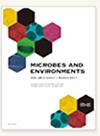Ferrihydrite Addition Activated Geobacteraceae, the Most Abundant Iron-reducing Diazotrophs, and Suppressed Methanogenesis by Heterogeneous Methanogens in Xylan-amended Paddy Soil Microcosms.
IF 2
4区 环境科学与生态学
Q3 BIOTECHNOLOGY & APPLIED MICROBIOLOGY
引用次数: 0
Abstract
Paddy fields are a major emission source of the greenhouse gas methane. In the present study, the addition of ferrihydrite to xylan-amended paddy soil microcosms suppressed methane emissions. PCR-based and metatranscriptomic ana-lyses revealed that the addition of ferrihydrite suppressed methanogenesis by heterogeneous methanogens and simultaneously activated Geobacteraceae, the most abundant iron-reducing diazotrophs. Geobacteraceae may preferentially metabolize xylan and/or xylan-derived carbon compounds that are utilized by methanogens. Geomonas terrae R111 utilized xylan as a growth substrate under liquid culture conditions. This may constitute a novel mechanism for the mitigation of methane emissions previously observed in ferric iron oxide-applied paddy field soils.在添加了木聚糖的水稻田土壤微生态系统中,添加亚铁能激活最丰富的铁还原重氮菌--革囊菌,并抑制异型甲烷菌的甲烷生成。
稻田是温室气体甲烷的主要排放源。在本研究中,向添加了木聚糖的稻田土壤微生态系统中添加亚铁可以抑制甲烷的排放。基于聚合酶链式反应和转录组学的分析表明,添加亚铁酸盐抑制了异型甲烷菌的甲烷生成,同时激活了最丰富的铁还原重氮菌--地杆菌科(Geobacteraceae)。Geobacteraceae 可能会优先代谢甲烷菌利用的木聚糖和/或木聚糖衍生碳化合物。土气单胞菌 R111 在液体培养条件下利用木聚糖作为生长底物。这可能是以前在施用氧化铁的稻田土壤中观察到的一种缓解甲烷排放的新机制。
本文章由计算机程序翻译,如有差异,请以英文原文为准。
求助全文
约1分钟内获得全文
求助全文
来源期刊

Microbes and Environments
生物-生物工程与应用微生物
CiteScore
4.10
自引率
13.60%
发文量
66
审稿时长
3 months
期刊介绍:
Microbial ecology in natural and engineered environments; Microbial degradation of xenobiotic compounds; Microbial processes in biogeochemical cycles; Microbial interactions and signaling with animals and plants; Interactions among microorganisms; Microorganisms related to public health; Phylogenetic and functional diversity of microbial communities; Genomics, metagenomics, and bioinformatics for microbiology; Application of microorganisms to agriculture, fishery, and industry; Molecular biology and biochemistry related to environmental microbiology; Methodology in general and environmental microbiology; Interdisciplinary research areas for microbial ecology (e.g., Astrobiology, and Origins of Life); Taxonomic description of novel microorganisms with ecological perspective; Physiology and metabolisms of microorganisms; Evolution of genes and microorganisms; Genome report of microorganisms with ecological perspective.
 求助内容:
求助内容: 应助结果提醒方式:
应助结果提醒方式:


